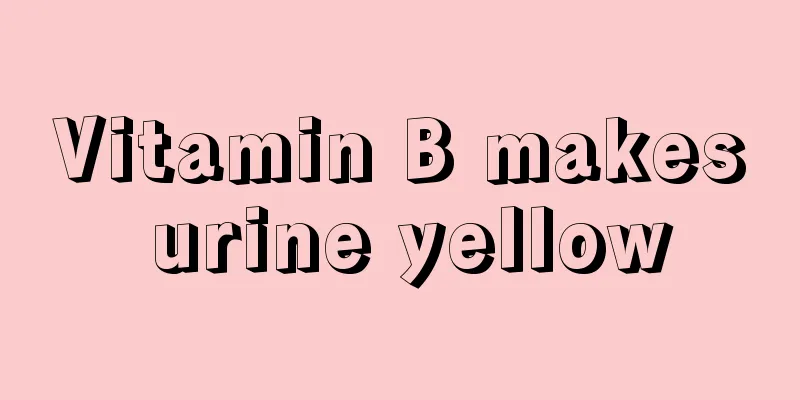Vitamin B makes urine yellow

|
There are many vitamins in our lives, and different vitamins produce different effects. Vitamin B is a very common vitamin among many vitamins. Many people have yellow urine after taking vitamin B. In fact, this is normal because vitamin B itself is yellow. Generally, if yellow urine appears after taking it, you can drink more warm water. If yellow urine still appears after stopping the medication, it is likely that other diseases have occurred in the body. Vitamin B is the general term for B vitamins, which include more than 12 kinds. Among them, 9 kinds are generally recognized as essential vitamins for the human body, and all of them are water-soluble vitamins. Pregnant women or babies who lack vitamin B are prone to skin diseases such as peeling hands and feet, eczema, and sore mouth corners. Each B vitamin has its own properties. Vitamin B1 (vitamin B1): also known as anti-beriberi vitamin. It is a white powder with a faint peculiar odor and bitter taste. It is easily soluble in water and easily decomposed in alkali. However, it is heat-stable in acidic solution, and oxidants and reducing agents can also make it ineffective. Its efficacy decreases in contact with light and heat, so it should be kept in a dark and cool place and should not be stored for a long time. Vitamin B2 (vitamin B2): also known as riboflavin, is a vitamin widely distributed in nature. It is an essential nutrient for mammals, and its coenzyme forms are flavin mononucleotide and flavin adenine dinucleotide. Vitamin B2 is an orange-yellow needle-shaped crystal with a slightly bitter taste. Its aqueous solution has a yellow-green fluorescence and is easily decomposed under alkaline or light conditions. Slightly soluble in water, soluble in sodium chloride solution, and easily soluble in dilute sodium hydroxide solution. Vitamin B3: also known as niacin and nicotinic acid, its scientific name is pyridine 3-carboxylic acid. It is a B vitamin that can be obtained by oxidation of niacin. Together with niacinamide, it is collectively called vitamin PP. It is the B vitamin that the human body needs in the largest amount. Vitamin B5: Also known as pantothenic acid, it is a white powder; odorless, slightly bitter; hygroscopic; its aqueous solution shows a neutral or weak alkaline reaction. It is easily soluble in water, very slightly soluble in ethanol, and almost insoluble in chloroform or ether. Vitamin B6: also known as pyridoxine, is a water-soluble vitamin that is easily soluble in water and alcohol, slightly soluble in fat solvents, easily destroyed by light or alkali, and not resistant to high temperatures. Vitamin B6 combines with phosphoric acid in the body to form pyridoxal phosphate or pyridoxamine phosphate. They are coenzymes of many amino acid metabolic enzymes and are therefore very important for amino acid metabolism. Vitamin B7: Vitamin H, also known as biotin and coenzyme R, is a water-soluble vitamin. Vitamin B9: Folic acid, also known as pteroylglutamate, exists in various coenzyme forms in cells and is responsible for the utilization of single-carbon metabolism. It is used to synthesize purine and thymine, serves as the raw material for DNA replication during cell proliferation, provides methyl groups to synthesize methionine from homocysteine, and assists in the conversion between various amino acids. Vitamin B12: also known as cobalamin, the anti-pernicious anemia vitamin, contains the metal element cobalt, and is the only vitamin that contains the metal element. Vitamin B12 is pink crystals. Its aqueous solution is quite stable in weak acid, but it is easily decomposed under strong acid and strong alkali. Sunlight, oxidants and reducing agents can easily destroy vitamin B12. When it is absorbed through the gastrointestinal tract, it must first combine with a glycoprotein (also called intrinsic factor) secreted by the pyloric part of the stomach before it can be absorbed. B12 deficiency due to lack of "intrinsic factor" should be treated with injections. In addition, other members of the B vitamins include B13 and B15, while B17 is actually not a B vitamin. |
<<: Can you still eat rice if it has moths?
>>: What is the cause of foamy sputum
Recommend
What medicine can be used for ovarian teratoma
Teratoma is a gynecological tumor disease that is...
Tips for removing nail polish
We often see some women wearing nail polish, and ...
Can brain cancer be checked by CT?
The most important and only way to determine whet...
What causes nipple pain during pregnancy
Many people experience nipple pain during pregnan...
Tips for transforming old clothes
Modern people's living standards are getting ...
How to reduce breast fat
Women's breasts will gradually develop as the...
Dietary recipe to relieve diarrhea in patients with colorectal cancer
Colorectal cancer patients often suffer from diar...
What kind of food is good to eat during confinement
During the confinement period, the mother should ...
Can I use ginger for foot soaking?
Ginger is an aromatic and spicy stomachic medicin...
Does jadeite nourish people?
Jade is a very precious ornament with extremely h...
What kind of disease is lymphoma
What kind of disease is lymphoma? It can be calle...
How to remove oil stains from clothes
The problem of oil stains on clothes is something...
What is the reason for pregnancy without embryo? The truth that expectant mothers must know
Pregnancy is a happy thing for every woman, becau...
Why does a pregnant woman's buttocks bone hurt?
During pregnancy, the uterus begins to slowly gro...
What causes cracked nails?
Under normal circumstances, the nails are relativ...









